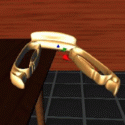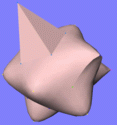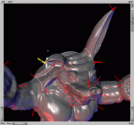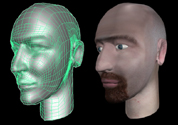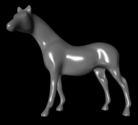| Course Syllabus
|
Morning:
The morning section will focus on the foundations of subdivision,
starting with subdivision curves and moving on to
surfaces. We will review and compare a number of different schemes
and discuss the relation between subdivision and splines. The
emphasis will be on properties of subdivsion most relevant for
applications.
Introduction and overview (Schröder); 15 min.
- Course outline and schedule
- High-level introduction to the basic ideas of subdivision
- Quick overview of application examples
Foundations I: Basic Ideas (Schröder)
60 min.
- Constructing smooth curves through subdivision; 10 min.
examples: b-spline knot insertion and interpolating subdivision
- Subdivision for surfaces; 10 min.
an example of a subdivision scheme: Loop
- Properties of subdivision schemes: smoothness, locality,
hierarchical structure; 10 min.
- How splines are related to subdivision; 10 min.
- Advantages of subdivision: arbitrary topology, efficiency,
controllable surface features such as creases and cusps; 10 min.
Foundations II: Construction and Analysis
of Subdivision Schemes (Zorin), 90 min.
- Overview of subdivision for surfaces; geometric smoothness. 15 min.
- Subdivision matrices for surface schemes; computing tangents and
limit positions 15 min.
- Classic schemes, their definition, and basic properties; 25 min.
- Catmull-Clark
- Doo-Sabin
- Loop
- Butterfly
- Midedge
- Kobbelt
- Subdivision rules for special surface features; boundaries
and creases; 15 min.
- Methods for constructing subdivision schemes; improving
smoothness, curvature continuity, mesh quality; 10 min.
- Computation of moments; 10 min.
- Basic algorithms and data structures for implementing
subdivision; adaptive evaluation, level-of-detail rendering; 10 min.
Afternoon:
The afternoon session will focus on applications of subdivision and
the algorithmic issues practictioners need to address to build
efficient, well behaving systems for modeling and animation with
subdivision surfaces.
- Applications and Algorithms:
- Interactive Multiresolution Mesh Editing, 40 min.
Subdivision can model smooth surfaces, but in many
applications one is interested in surfaces which carry
details at many levels of resolution. Multiresolution mesh
editing extends subdivision by including detail offsets at
every level of subdivision, unifying patch based editing
with the flexibility of high resolution polyhedral
meshes. The result is a hierarchical editing system built
around highly adaptive algorithms and datastructures to
deliver interactive performance on low end workstations
for complex geometric models. This section will detail
the underlying ideas and the algorithms necessary to build
a scalable multiresolution editing system. (Zorin)
- Exact Evaluation of Subdivision Surfaces
Until recently it was believed that subdivision surfaces
(Catmull-Clark, Loop, Doo-Sabin, ...) could not be
evaluated exactly everywhere. This talk disproves this
belief and presents the ideas and techniques that enable
exact evaluation. Evaluation is important as it allows
many standard algorithms developed for parametric
surfaces to be applied to subdivision surfaces. The
evaluation technique relies on a new set of eigen-basis
functions which depend directly on the eigenvectors of
the subdivision matrix. The cost of the resulting
evaluation scheme is comparable to that of a bi-cubic
spline for the case of Catmull-Clark subdivision. The
emphasis of this talk is on an intuitive understanding of
the mathematical techniques and on practical applications
of the evaluation schemes. (Stam)
- Subdivision Schemes for Fluid Flows, 40 min.
The motion of fluids has been a topic of study for
hundreds of years. In its most general setting, fluid
flow is governed by a system of non-linear partial
differential equations known as the Navier-Stokes
equations. However, in several important setting, these
equations degenerate into simpler systems of linear PDEs.
This section will show that flows corresponding to these
linear cases can be modeled using subdivision schemes for
vectors. These schemes expressed the flow as the limit of
an increasing dense set of vector fields. The beauty of
this approach is that realistic flows can now be modeled
and manipulated in real time using their associated
subdivision scheme. The section will conclude by
discussing a number of practical details that arose in the
implementation of such a scheme. (Warren)
- A Variational Approach to Subdivision, 40 min.
Surfaces generated using subdivision have certain orders
of continuity. However, it is well known from geometric
modeling that high quality surfaces often require
additional optimization (fairing). In the variational
approach to subdivision, refined meshes are not prescribed
by static rules, but are chosen so as to minimize some
energy functional. The approach combines the advantages of
subdivision (arbitrary topology) with those of variational
design (high quality surfaces). This section will describe
the theory of variational subdivision and highly efficient
algorithms to construct fair surfaces. (Kobbelt)
- Subdivision Surfaces in the Making of Geri's Game and A
Bug's Life, 40 min.
Geri's Game is a 3.5 minute computer animated film that
Pixar completed in 1997. The film marks the first
time that Pixar has used subdivision surfaces in a
production. In fact, subdivision surfaces were used to
model virtually everything that moves. Subdivision
surfaces went on to play a large role in the recently
released feature film 'A Bug's Life' from Disney/Pixar.
This section will describe what led Pixar to use
subdivision surfaces, discuss several issues that were
encountered along the way, and present several of the solutions
that were developed. (DeRose)
- Summary and Wrapup: (all speakers)
|
